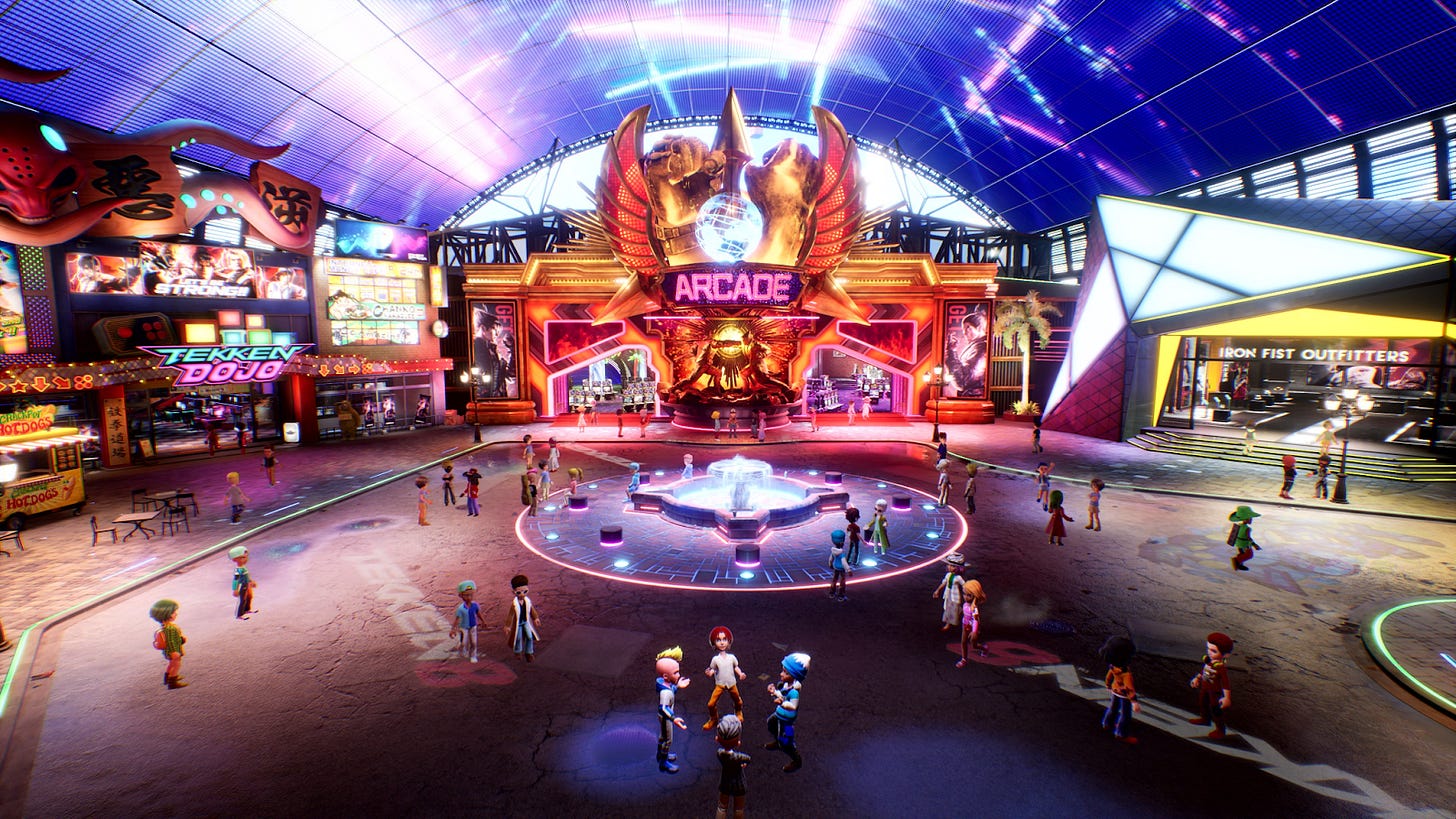Tekken 8’s First Month and Bright Future
Capcom's newest title is the perfect playground for newcomers and veterans alike.
Written by BoofyBaps (@boofybaps)
It's fair to say that the release of any game is often problematic and prone to cultivate rage. With games designed to be played online, this is exacerbated tenfold as developers also need to account for international playability. A fighting game is begging to be heavily criticized on release as online play needs to be frame-perfect, each character needs to be equally powerful without any exploitable overpowered ability, and there must be a rich offering of single-player content that will only matter during the first two weeks of the game’s release.
Following the critical and commercial success of Street Fighter 6, Capcom set a new bar for AAA fighting games. Now players know what it’s like to have a robust single-player offering, nearly frame-perfect online net code, tools for self-expression, and well-balanced fighting gameplay that maintains and even improves on the established formula. Street Fighter 6 has thrown down the gauntlet, daring the next two AAA fighting games set to release in the following months, Mortal Kombat 1 and Tekken 8, to meet the challenge.
After an intensely negative reception to Mortal Kombat 1’s release, it was up to Bandai-Namco to step up to the plate and show that Capcom isn’t the only company that can make a game truly worth its $70 price tag. I’m here to tell you that not only did Tekken 8 rise to that challenge, but in my opinion, they raised the bar even higher. The month we’ve had with this game has gotten me excited for the upcoming years of personal enjoyment with it and what the game can bring to the fighting game community as a whole.
Is it Too Late To Play?
The first month of a fighting game’s release is a special time. Everyone is still discovering how to play, veterans are learning the new mechanics, and a host of starry-eyed new players show up to fight each other in the lower ranks to decide who will become a lifelong fan and who will throw their controller across the room and return the game in the morning. This is the period where those who will play this game for years will wiggle into their appropriate ranks, hone basic strategies, and learn the fundamentals. The fabric woven by early adopters' loose and playful actions will eventually harden and become a less-than-penetrable wall of practice, knowledge, and newbie abuse.
Unfortunately, for players who have not yet seen the light by the time the first month has passed, fighting games tend to get much harder. Some people hang out online in lower ranks, learning optimal ways to torment beginners for the mild satisfaction of bullying someone with less experience. The last few years of Tekken 7 made a very dense barrier to entry, and it is easy to worry about Tekken 8’s longevity with all of the cruel, cancerous griefers being unable to move up to high ranks with seasoned, knowledgeable players or move on to other games. However, I am not worried.
Tekken 8 is Perfect for New Players
The onboarding experience for new fans is the best I have ever seen. The story mode is arguably the best in the series. It provides opportunities to try out many different characters while maintaining a narrative thrust that will get you to connect emotionally to many of them. New Xiaoyu mains like myself can attest to this because she is a sweet angel who deserves the world and many Ws.
Then, after the story mode is complete, every character has a short 5-round tournament that ends in a cutscene made with the same polish as the main campaign. The stories are mostly silly and non-canon, but each one is a special treat at the end that motivates you to test out every character. The CPU in these segments is easy, but the final two rounds bump up to medium. You can usually mash your way through everything in these segments, but it gives you just enough pushback to make you try a few different tactics for each character. For me, this showed me which characters I enjoy playing on a purely sensory level and helped me whittle down my choice of a main.
Moving onto the Arcade Quest mode is the next best way to start choosing and learning your favorite characters. Each level is an arcade in a different city with a different average skill level. At each arcade, a new gameplay element is introduced for your specific character via a tutorial. After completing the character stories, you’ll likely have four to five characters you like the most. I would suggest hanging around the starting area and fighting all the players there to test your favorites further until you find the one or two you like most and continue with the rest of the campaign.
The CPU is better than ever, making it difficult to win without understanding a few fundamental lessons. It will happily punish unsafe attacks and exploit openings with short combos. You likely won’t walk out of a purely CPU fight diet with enough knowledge to rise the ranks to Tekken God. Still, it can help you get familiar enough to get some starting wins and rise to the earliest ranks without feeling completely overwhelmed and depressed.
Knowledge is Power
The single-player content only matters a little for those of us who bought the game on day 1. However, any new player who gets the games from here on out will need to interact with the single player deeply. My experience with Tekken 7 was a huge struggle, joining in seven years after the game’s release. The people still playing the game were experts, and I hadn’t even gotten the chance to learn the game yet. Despite a single-player story campaign, character episodes, and the practice mode, there was not much to do to learn the game. Most of my time in Tekken 7 was being bounced up and down the beginner ranks, facing people with suspicious amounts of knowledge and skill.
One of the best features for starting players is total loss forgiveness for the first nine ranks. The game writes off all your losses until you hit the Warrior rank. At this point, you can be demoted back down the ladder. Some were surprised that so much leeway was given to those ranks, as being a yellow rank in Tekken 7 took much more practice and skill. I think it’s a brilliant idea. Demotions add an extra sting to losses that might push away the fighting game-curious. You might lose 90% of your games, but if you keep playing, that 10% will still reward you.
Ultimately, if someone fails to gain those skills, they won’t be in the yellow ranks for very long. However, if that person with a 10% win rate makes it to Warrior (on average, this can be accomplished by winning about 30 matches), that means the player has played around 300 Tekken matches. I’d be surprised if they failed to gain any skill or knowledge in that time. I’d say they had probably learned a lot, and this hypothetical slow learner may be able to compete with the more prodigious players. If those wins failed to manifest any benefit early on, there is a chance this player would not have played 300 matches of Tekken and fallen out of the hobby entirely.
Extra Features Help Fight Frustration
Tekken, and all games that require competitive play, are inherently personal emotional experiences. To overcome a hurdle, you must first overcome yourself. At a certain rank, your abilities as a player will stall. Oftentimes, your mental understanding of what happens surpasses your capabilities. You watch yourself in real time, make mistakes, and fail.
It’s common to witness in fighting games, especially when players lose their sense of reason and blame the game or the other players for their failures. This often creates situations where players act aggressive or hostile. Learning to overcome that frustration and remain in control of yourself is just as important as learning frame data and practicing combos. While this is typical of fighting games in general, Tekken 8 may have the best answers to these problems.
The #1 piece of advice I give anyone attempting to learn a fighting game is to take a break when you stop enjoying yourself. Often, this meant turning the game off and eating a strawberry in a field or something. Now, thanks to the geniuses at Bandai-Namco, you can do so many things in the game besides grinding online and practice mode. The game is packed with many features to blow off steam and interesting ways to learn and engage with the game that do not require fighting a human.
These exciting and educational features include “super ghost battle,” which records the tactics and strategies used by other players and has a CPU recreate them so you can practice defense against them. You can download ghosts from any player, even the best players in the world. I started fighting the ghost of the top player for my main, Xiaoyu and it has taught me so much about the character I never even realized was possible.
An incredibly in-depth replay feature records all of your battles and allows you to replay them while suggesting counters, punishes, and combos for certain situations. Replays are also publicly made for all players, including top-level gameplay, which can be just as entertaining as it is educational.
There is also Tekken Ball, which is like a normal fight but with a giant beach ball between you that you can hit at one another, and the jukebox mode, which allows you to replace any of the game’s menu or stage songs with one of the songs from the near-complete collection of music from previous games (where on God’s green earth is the Tekken 2 opening theme, Harada?!).
The True Cost of 400 Tekken Coins
Everything was perfect for a Tekken fan up until February 16th, when the Tekken Shop was announced. Yes, the same microtransaction monetization strategies that earned Mortal Kombat 1 its negative reception were revealed after three weeks of endless praise. However, a much larger percentage of Tekken fans seem much more apt to defend Bandai-Namco than MK fans were Netherrealms. This forgiveness is based on two fronts:
Tekken’s base game offerings provide a complete experience with enough content and customization options for the average person to have a good time expressing themselves while engaging with the game. Mortal Kombat 1 was a much more meager offering, missing fan-favorite game modes and featuring incomparably fewer customization options.
The Tekken shop will charge $4 for the first crop of character skins, which will likely be fully color-customizable. Compared to Mortal Kombat 1’s $10 skins, Tekken 8’s microtransactions lean much more into the “micro” aspect.
Regardless of the controversial microtransactions, Tekken 8 is one of the greatest fighting games in history for new potential fans of the genre. The first month provides special access to other beginners that will never be as potent. Still, I’m hopeful that with all of the ways this game makes the environment healthy for newcomers, there will continuously be new people hanging around to fight each other and learn how to play. I’m deeply invested in the overall growth of the fighting game community, and I believe Tekken 8 is one of our greatest boons.










